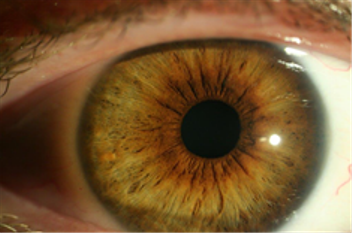Irodology part 2

Iridology represents a holistic approach to health care because it attempts to analyze and diagnose weaknesses in all of the tissues of the body. The eye is seen merely as an instrument unlocking the many clandestine symptoms of the body. Just like an x-ray, thermometer, a sphygmomanometer (blood pressure instrument) etc. reveal the body's overall condition and can give clues as to what specific organs are affected, so too does the iris of the human eye. The iris contains hundreds of nerve ending which are attached to the optic nerve, the base of the brain, and all of the tissues of the body. Therefore, the neural circuitry of the eye is able to express the continuity of the body, an integrated unit composed of various cells which all communicate with the irides about their overall wellness. Weaknesses in body tissues or organs often show up in the eye before they show up in medical tests.
What can be identified through iridology?
The iris can be divided into different sections relating to the lymphatic system, mesenchyme, gastrointestinal system, skin, liver functions, kidneys spleen, cardiac risks, immune function and endocrine functions to name a few. We can also look at how many of these systems interact through the application of emotional dynamics and the psychoneuroimmunology. Iridology helps to identify the underlying pathways to a condition – so a patient may attend for Iridology examination not for a complete ''medical diagnosis”, but to pinpoint the causes of a problem and learn how these can be treated, balanced or supported. Many patients come with a specific long-standing condition, such as with arthritis, constipation, eczema, asthma etc. A smaller percentage who attend are healthy and wish to remain that way - this is where Iridology’s role as a preventative technique comes to the fore, as we can identify personal genetic tendencies and predispositions and the degree of risk to that individual. Iridology can often reveal the cause of a condition and also many factors which are necessarily tested for in conventional medicine, but can cause a multitude of problematic symptoms for a patient, such as in Adrenal Fatigue Syndrome, Dysglycaemia – erratic blood sugar levels, Intestinal Dysbiosis or Borderline Hypothyroidism.
What we cannot assess through Iridology
For various reasons iridology is not a panacea and the following cannot be detected through analysis of the iris, pupil or inner pupillary border:
· Bacterial infections
· Psoriasis · Gallstones
· Kidney stones
· Pregnancy
· Length of life
· Loss of organ via surgery (Russian research revealed that the general anaesthetic short-circuits the nervous system in such cases)
· Some types of tumours
· Leukaemia
· Rare genetic conditions (due to lack of experience & research)
One can however see signs which will indicate that there is a condition in need of further physical examination and blood tests. These can only be carried out by your naturopath or medical doctor.
The Benefits of Iridology
The beauty of Iridology is that it provides us with analytical or diagnostic clarity on many levels. It helps the practitioner to pinpoint the foundation or cause to a problem or identify the contributing pathways to a particular symptom or collection of symptoms. For example, migraines can be triggered via many different causes, such as erratic blood sugar levels, low progesterone levels, liver congestion, chronic sinusitis, certain food allergies initiated via the intestinal immune system or even neuromuscular tension connected to the cervical vertebrae. This could prove to be an overwhelming list of symptoms for the patient and the practitioner! Yet a professionally trained iridologist will be able to differentiate between all these causes and focus on the root cause of the problem, through microscopic analysis of the iris, pupil and inner pupillary border.

With any approach in natural health it is essential to identify the foundation to a condition and not just try to address the symptoms, which are, after all, the tip of the iceberg for what is the true nature with most degenerative diseases and chronic conditions. What many practitioners appreciate about Iridology is its versatility and flexibility, plus the fact that it can be integrated to just about every treatment approach we have. Around the world Iridology is applied in the natural health, chiropractic, GP or specialist’s clinic to clarify the underlying cause of a problem. Iridology is utilised successfully by naturopaths, homeopaths, medical herbalists, pharmacists and medical doctors.
Iridology Research
Iridology has a basis of official scientific and medical research in such countries as South Korea, Russia, Romania, Belarus, Latvia & the Ukraine for many decades. Many research and results have been sponsored and accepted officially by health departments and hospitals in these countries. In more recent times Iridology research has increased at a dramatic pace, although these endeavours have not been officially sponsored. Many worthwhile research initiatives have expanded our knowledge or answered contentious questions in iridology. Research has taken place in Greece, Italy, Spain, Portugal, Cuba, Brazil & England.
Iridology in practice.
With the use of sophisticated iris microscopes and photography, iridology is rapidly advancing .These instruments are very essential for a complete iris analysis of a patient. The practice of Iridology takes many years to perfect and should preferably be done by a naturopath, homeopath or medical doctor as one needs a good knowledge of medicine, anatomy &physiology and pathology, in order to treat and advise patients who present with any type of condition or illness.
Please remember that you hold the key to your health and as a Naturopath and member of South African Academy of Intergrative Medicine, I always believe that prevention is better than cure.